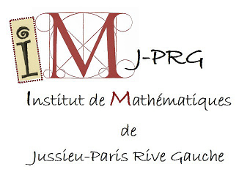

| Equipe(s) | Responsable(s) | Salle | Adresse |
|---|---|---|---|
| Doctorants |
Théo Pinet et Juan Ramón Gómez García |
À déterminer | Sophie Germain |
Séminaire permettant aux doctorants et étudiants de Master de l'IMJ-PRG (de toutes les équipes) de se familiariser avec les résultats apparaissant dans les récentes prépublications de leurs collègues. L'objectif des présentations est d'expliquer de manière accessible, à l'aide d'exemples et/ou de cas particuliers plus simples, les résultats principaux d'une prépublication donnée. Le séminaire est à distinguer du Séminaire des thésards par sa volonté de se concentrer sur les résultats de recherche propres aux étudiants de l'IMJ-PRG (et non pas aux résultats généraux et définitions abstraites du domaine de recherche sous-jacent).
Aura typiquement lieu les mercredis de 17h00 à 18h30-19h00.
| Orateur(s) | Titre | Date | Début | Salle | Adresse | ||
|---|---|---|---|---|---|---|---|
| + | Juan Paucar | Isoperimetric Profiles and Regular Embeddings of locally compact groups | 15/05/2024 | 17:00 | Sophie Germain | ||
In this talk I will introduce the notion of amenability of infinite graphs and groups. I will start by proving an isoperimetric inequality on the 4-regular tree by a ponzi scheme argument, this will motivate us to define the notion of Isoperimetric profile. We will then proceed to motivate the definition of Quasi-Isometries as a large scale analog of BiLipschitz Equivalence that preserves this Isoperimetric Profile. In the second part of the talk I will discuss an asymmetric version of Quasi-Isometry called Coarse Embedding and explain the main terms of the main theorem of the article presented. |
 | ||||||
| + | Maissâ Boughrara | Sharp non explicit blow-up profile for a nonlinear heat equation with a gradient term. | 17/04/2024 | 17:00 | |||
During the first part of this talk, we consider the semilinear heat equation with a pure power nonlinearity, which is a less complicated version of some famous PDEs, where we can observe the phenomenon of blow-up that occurs in some solutions for this equation. We will recall some famous results related to a class of these solutions, called solutions of type I, such as the existence and the notion of blow-up profile near the singularity. In the second part, we consider a nonlinear heat equation with a nonlinear term depending on the unknown and its gradient, which is a more general case than the previous equation. In the earlier literature, we have the existence of a stable blow-up solution with an explicit profile. By pursuing a limited development, we are trapped in scales of order $\frac{1}{\log |T − t|^\nu}$ where $T$ is the blow-up time. In this work, we are able to provide a sharper description up to $|T −t|^\mu$. The price to pay is to replace the explicit profile by a non explicit profile, which is in a fact a well-prepared blow-up solution of the semilinear heat equation with a pure power nonlinearity. |
 | ||||||
| + | Élie Studnia | L'image du produit tensoriel des représentations galoisiennes associées à deux formes modulaires | 03/04/2024 | 17:00 | Salle 1016 | Sophie Germain | |
"Étant donné une forme modulaire propre parabolique f à coefficients dans un corps de nombres L et un idéal premier \lambda de L, Shimura, Deligne et Deligne-Serre construisent une représentation bidimensionnelle V_{f,\lambda} du groupe de Galois absolu de Q à coefficients dans L_{\lambda}." -------------------------------------------------------------------------------------------------------
"Given a cuspidal newform f, with coefficients in some number field L, and a prime ideal \lambda of L, Shimura, Deligne and Deligne-Serre construct a bi-dimensional continuous representation V_{f,\lambda} of the absolute Galois group of Q with coefficients in L_{\lambda}." |
 | ||||||
| + | Francesca Rizzo | Groups acting on moduli spaces of hyper-Kähler manifolds | 20/03/2024 | 17:00 | |||
A hyper-Kähler (hK) manifold is a simply connected compact Kähler manifold whose space of holomorphic 2-forms is generated by an everywhere non-degenerate form. They appears naturally in the study of compact Kähler manifolds with trivial real first Chern class. Having fixed a deformation type, there exists a moduli spaces parametrizing hK manifolds of that type. Its connected components can be embedded (via the period morphism) in a period space, that is the quotient of a Hermitian symmetric domain by an arithmetic group. In the preprint, following work of Stellari and Gritsenko-Hulek-Sankaran, we study the ramification of covering maps between these period spaces that arise from the action of some groups of isometries. The talk is divided in two part, in the first one I will introduce hK manifolds and present the main results in the study of their geometry. In the second part I will explain the results of the paper on the action of arithmetic groups on period spaces, and the strategy of proof (which uses tools from lattice theory). https://arxiv.org/abs/2304.05480 |
 | ||||||
| + | Pierre Godfard | Rigidity of Fibonacci representations of mapping class groups | 06/03/2024 | 17:00 | 1016 | Sophie Germain | |
In this preprint, it is shown that the family of level 5 WRT SO(3) representations, also known as Fibonacci representations, of mapping class groups of surfaces are rigid (ie. admit no non-trivial deformations). |
 | ||||||
| + | Tommaso Scognamiglio | A generalization of Kac polynomials and tensor product of representations of Gl_n(F_q) | 21/02/2024 | 17:00 | Salle 1016 | Sophie Germain | |
In this preprint, it is shown how to relate the computation of certain invariants in the category of (complex) representations of the finite general linear group Gl_n(F_q) to the representation theory of quivers. This generalizes a preceding result by Hausel, Letellier and Rodriguez-Villegas concerning the " generic " case. The talk is divided into two parts. In the first part, I will introduce and define the objects we are interested in and review the known results about the generic case. In the second part, I will explain the main result of the paper and its strategy of proof, through some concrete examples. https://arxiv.org/abs/2306.08950 |
 | ||||||